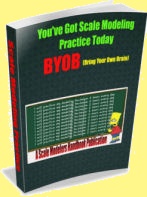|
Scale Model Practice Today: BYOB(Bring Your Own Brain)Instantly Download Your Own Comprehensive Modeling Practice Guide How we learn new Modeling Techniques Who ever heard of practicing modeling, I’ll get my practice by working on my current project, the famous learn-by-doing model that results in many oops utterances until we reach the point of having to junk a pretty expensive kit. Isolate a particular problem, or new element you want to learn. Focus your practice time on these specifics. Concentrate not only on these specifics but each individual modeling technique until you get it. Exaggerate by slowing down your moves, to the point you can see every detail. Finishing it is not half as important as seeing everything that goes into your routine. For instance, how you hold a knife or brush, the way you apply masking.Repeat---Once you have the details fixed in your mind, repeat the step 10-20 times keeping track of how many you make a mistake and analyze them to correctRx For Modelers Block
But that was the knowledge of a journalist; read an article, research and interview the subject and write something new, fresh and hopefully better. I have learned from reliving some of these past byline racks that my knowledge of the subject was superficial and lacked depth from having actually put it into practice. This fourth stint in modeling needs a fresh slant. I need to get beyond my comfort zone; I need to develop a plan, a set of goals projecting what I want to accomplish with this hobby. So, what’s a reasonable goal for my scale modeling at 68 years young. I am not planning to turn pro, I don’t see myself as collecting awards of any kind, so if it is not a money making endeavor. What do I want? 1. I want to enjoy this hobby to its fullest, to enjoy it I need a reasonable number of successes in my own mind. 2. I would like to contribute something so others can get more enjoyment from the game. 3. I want to create the best models I am capable of in projects that please me. What I recall about setting goals from past seminars. Let’s see if it works here. · Goals should focus on only the 2-3 elements that are most important. · Goals need to be specific, not vague and fuzzy. · Goals should be attainable but still challenging. · Goals should be visualized, as you would a finished model. · Goals should be written down and read daily. I came up with two goals for both practice and an actual build. Attitude: I Am Here To Have Fun I can honestly say my practice sessions have not shown less than an “I’m here to have fun” attitude. They have shown a lack of concentration, consistency and yes even courage. In our day to day lives, the virtue of courage doesn't receive much attention. Courage is a quality reserved for soldiers, firefighters, and activists. Security is what matters most today. Perhaps you were taught to avoid being too bold or too brave. It's too dangerous. Don't take unnecessary risks. Don't draw attention to yourself in public. Follow family traditions. Don't talk to strangers. Keep an eye out for suspicious people. Stay safe. As a result, embarking on a $500+ build of a period warship was pretty low on the totem pole in terms of gauging success. What I lacked was a real solid plan for practicing. It needs to be a plan that is based on growing knowledge, therefore it needs to be flexible. It needs to provide an action strategy and though it needs certain risk to challenge me, it has a have a “Do It Now approach. Check Here For New Practice DrillsSetting Ratlines With The Little Surprise
The rigging of a ship model is where an outstanding model separates itself from even moderate quality models or kits. A high quality ship model should, foremost, have tight and full rigging. A strong rigging will mean the model will keep its overall look for many years to come. In contrast, a low quality rigging is one where the rigging can be stretched and has not been properly fastened. A poor quality rigging will start sagging with time and reduce the appearance of the ship model. This is where an active practice regimine will really pay off. The ability to string the standing rigging on a mock-up of a main mast, in particular, the shrouds and ratlines can make your modeling go much faster when you get to the real thing. I have a styrofoam block that's about a foot in length, 4 inches across and about 1.5 inches deep, the Good Ship Styro. Into its surface I drilled 3 holes lengthwise on the centerline about 3 inches apart. Here I "step masts" for shrouds and ratlines practice. The idea is to string the shrouds over the lower mast's mastcap and drop them down to deadeye level where I have inserted common pins deep into the "hull" of the styro and here's a neat Strick: put a slit in the edge of a stiff piece of thin plexiglass. One for each shroud. Run the shroud line around its pin and then run it back to the plastic which you have pinned to the "stern" of the USS Styro nd pull the line through a slit to hold it tight. Next, you need a guide sheet for instlling the ratlines. I like to use the clear plastic ratline "sets" which come with plastic models for this purpose by tack gluing it to a similar sized piece of cardstrock cut to roughlythe same size. set this between thee Styro deck and the mast top. It will serve two purposes whether you are practicing or working on the real thing (1) it is your guide for placement of the ratlines and (2) it is the support for your installation process. Each intersection between shroud and ratline is knoted with a simple overhnad knot. The knot itself is firm, but the line between shrouds is limp and will be tightened after ratlines are all placed by setting the witfhof the outer shrouds on their deadeyes. At that point dab a small drop of CynoAcylate (CA) adhesive to each knot. For practice I like to build two or three sets of ratlines. If your results satisfy you, set them aside for use on the actual model. |
Modeling Resources




All Four and Save






